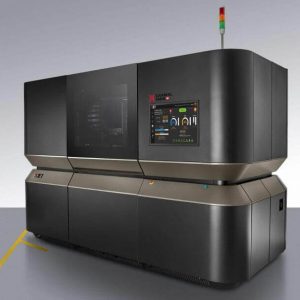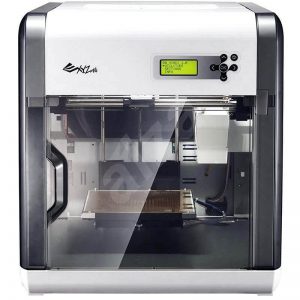Worldwide
Filter
Showing 241–260 of 260 results
PROS:
- Huge build volume.
- Ability to print with multiple materials.
- Touch screen interface.
- Build-in camera.
CONS:
- The closed system of 3D printing.
- Post-processing of parts and functional prototypes is an issue.
PROS:
- Automatic bed leveling
- Filament run-out sensor
- Fully color display
- Newly designed electronics
- Removable magnetic extruders
- Multi filaments compatible
CONS:
- The open body of the printer would not let it accumulate a lot of temperature in a short span of time as closed body printers would.
PROS:
- Unmatched print quality
- Provides huge build tray and for manufacturing large parts with ease
- High operational efficiency.
- Huge touch screen interface.
- 5 times faster print speed than metal 3D Printers
- Saves wastage and very well designed
- Users can optimize the cost of the parts utilizing the best possible design choices.
CONS:
- Demands lots of investment of money, time, space and efforts.
- Not suitable for home users.
PROS:
- Unsurpassed part quality with 99.9 percent density, isotropic uniformity, and extremely low shrinkage can be printed using Carmel 1400 M.
- The printer offers an unprecedented level of design freedom to its users by letting them control every minute aspect of the 3D printing process which wasn’t possible before. It permits the making of complex geometries, fine details, nearest net shapes as well as smooth surfaces.
- Carmel 1400 M delivers unrivaled operational efficiency by providing automated support planning, easy support removal, and simple and safe operation.
- It guarantees to provide no material waste.
- Compatible with user-friendly software.
- Features a large touch screen user interface for letting users simply control and monitor various functions.
CONS:
- Various aspects of the printer are very complex and thereby demand in-depth knowledge about the printing technology for understanding.
PROS:
- Super simple to use, ready to work out of the box.
- Features easy-to-install filament cartridges.
- Has an enclosed print area.
- Offers a huge build volume.
- Free online gallery, and 3D modeling software.
- Heated Bed.
CONS:
- The cooling isn’t very impressive.
- No removable bed.
PROS:
- The da Vinci 2.0 A Duo is a dual extrusion printer, so adding more color to your prints would mean no problem at all. In addition to this, both cartridges fit comfortably inside the printer’s external shell so the complete printer's aesthetics won't be compromised.
- Another perk of the printer is its Cloud storage wherein your design files are stored virtually, so you won’t have to worry about misplacing your computer files or USB storage device. There is also something called the Members’ Gallery. This is a great place to share, discover, rate, and collect designs that interests you.
- Automatic maintenance features such as print bed detection, which sets the ideal distance between the da Vinci 2.0 A Duo's printing platform and extrusion nozzle. Additionally, there is an automatic nozzle cleaning that helps prevent clogging. All the software upgrades of this printer also happen automatically.
- You can choose to view menus and prompts using the da Vinci 2.0 A Duo, which will display on the 2.6,” 4×16 FSTN LCM display, in either English or Japanese.
CONS:
- All the technological add ons in this desktop 3D printer all adds up to the weight of the 3D printer which makes it in total weighing about 60 pounds. This could be a challenge if the printer must be frequently relocated according to your working need.
PROS:
- Easy to use
- Enclosed frame
- Auto calibration
- Auto filament feeding
- Affordable
- Portable
CONS:
- Print quality isn’t exceptional
- Non-heated build plate
- Non-removable print bed
- Proprietary software is slow
PROS:
- Multilingual touch screen interface is something you would not get to see with many 3D printers falling in the same price range. Hence, offering a user-friendly interface for setup. At the same time, enabling users from different geographical regions to experience printing with Da Vinci Jr. 2
- Da Vinci Jr 2.0 Mix can be connected using multiple modes.
- Bed leveling can be done automatically.
- Has an excellent print speed.
- Offers a wide layer resolution range.
- Provides considerable positioning accuracy.
- Multi-color 3D printing is possible.
CONS:
- Build volume of the printer isn’t too much
- Closed print chamber with a non-removable print bed may create problems when removing printed parts.
PROS:
- It is very simple to use
- Highly affordable
- Intuitive Software and User-Friendly Interface
- Decent Quality prints
CONS:
- Support for only proprietary filament limited to PLA and PETG
- Slow printing speed
PROS:
- Can produce clean parts with complex geometry
- Needs less post-processing steps
- Printing is easy with Nobel 1.0
- Cheaper than most of the SLA printers
- Great for printing small parts with a detailed design requirement
CONS:
- Layers are visible when checked closely
- Fine Details may be inconsistent
- Very slow when compared to other SLA printers
- Does not support Mac OS
- Limited material support
PROS:
- Ready to use soon after some procedure.
- Produces high-quality prints.
- Even complex models are easily printed.
CONS:
- The printer has a slow printing speed.
- Models printed using this printer require cleaning.
- The resins in this printer have a strong smell.
PROS:
- Allows you to print with multiple materials.
- Gives you a layer resolution range of 50 microns to 700 microns depending on your build speed.
- A hardened steel nozzle enabling you advanced material usage.
- A heated chamber guaranteeing you excellent 3D print quality.
- Auto leveling and calibration ensuring high precision.
- Automatically replenishing the filament when a filament is finished.
CONS:
- Cooling of parts is a problem because the printer has a closed body.
PROS:
- Reliable CNC carving, laser engraving, 3D printing, and paste extrusion.
- User-friendly printer.
- Efficient design.
CONS:
- Price.
- Printing with limited filaments.
PROS:
- High quality print
- Plug and play design
- Automatic calibration
- Dual extruder
- Compatible with soluble support material
- Print with different usual and flexible materials including PEEK
- Allows the use of third party materials
CONS:
- Expensive and solely for industrial use
PROS:
- The printer has a one-way operation process starting from importing print to slicing it.
- The user interface displays comprehensive information to every user that’s helpful for a first-timer who is not all tech-savvy.
- Inspire comes with a self-built model library.
CONS:
- The menu layout of this printer could be improved to make it more user-friendly than it currently is.
PROS:
- Automatic bed leveling.
- Filament run-out sensor.
- Closed print chamber.
- Compatible with external filaments.
- HEPA air filter.
- Able to print in two modes.
CONS:
- Post-processing of parts and functional prototypes would be difficult.
- Shorter print volume.
PROS:
- Automated bed leveling
- Sleep mode
- Filament out sensor
- Sturdy body
- Reliable
- Provides a complete ecosystem of hardware and software
- Third-party filament support
CONS:
- Not affordable for fun use
- No dual extruder
- Results with third party filaments aren’t as impressive as it is with their proprietary materials
PROS:
- The printer definitely offers one of the highest build volumes in terms of the price that it charges its users. So, professionals in the field of 3D printing and even intermediates can opt for this printer.
- Parts and functional prototypes manufactured using M300 offer a layer resolution range of 90 to 290 microns which is very high compared to other 3D printers based on the same 3D printing technology.
- The brand is reliable for manufacturing desktop 3D printers of high end and is known to give extraordinary customer support.
CONS:
- Although Zortrax M 300 offers good print quality, its price is rated much higher, and in case you are fine without having the reliability and are willing to let go of a little bit of quality, you will get many options cheaper than this 3D printer because its price is expensive.
- There is only one way to connect to this printer that is using an SD card which is a little bit slower process than the Wi-fi connectivity and is offered by competitors in the same price range.
PROS:
- Enclosed frame
- Large build space
- Easy to set up with automatic bed leveling
- High-quality prints
- WIFI connectivity
- Filament run-out sensor
- Remote monitoring
CONS:
- Expensive for those wanting to use the printer for fun and learning
PROS:
- Direct metal parts and functional prototypes can be produced.
- Parts have high mechanical properties and high relative density in which post-processing is necessary.
- A wide range of materials to choose from.
- Parts that otherwise take days to complete can be made in hours using this printer.
CONS:
- Post-processing of parts or functional prototypes is a very hectic process and that might increase the overall printing time while you are having a batch production.





















